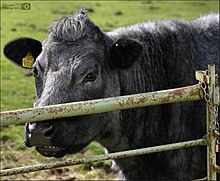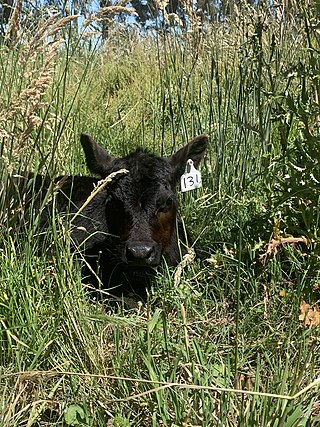
A calf is a young domestic cow or bull. Calves are reared to become adult cattle or are slaughtered for their meat, called veal, and hide.

The Highland is a Scottish breed of rustic beef cattle. It originated in the Scottish Highlands and the Western Islands of Scotland and has long horns and a long shaggy coat. It is a hardy breed, able to withstand the intemperate conditions in the region. The first herd-book dates from 1885; two types – a smaller island type, usually black, and a larger mainland type, usually dun – were registered as a single breed. It is reared primarily for beef, and has been exported to several other countries.

The Brahman is an American breed of zebuine-taurine hybrid beef cattle. It was bred in the United States from 1885 from cattle originating in India, imported at various times from the United Kingdom, from India and from Brazil. These were mainly Gir, Guzerá and Nelore stock, with some Indu-Brasil, Krishna Valley and Ongole. The Brahman has a high tolerance of heat, sunlight and humidity, and good resistance to parasites. It has been exported to many countries, particularly in the tropics; in Australia it is the most numerous breed of cattle. It has been used in the creation of numerous taurine-indicine hybrids, some of which – such as the Brangus and Brahmousin – are established as separate breeds.

The Galloway is a Scottish breed of beef cattle, named after the Galloway region of Scotland, where it originated during the seventeenth century.

The Simmental or Swiss Fleckvieh is a Swiss breed of dual-purpose cattle. It is named after the Simmental – the valley of the Simme river – in the Bernese Oberland, in the canton of Bern in Switzerland. It is reddish in colour with white markings, and is raised for both milk and meat.

The Dairy Shorthorn is a British breed of dairy cattle. It derives from the Shorthorn cattle of Tees-side, in the North Riding of Yorkshire and in Northumbria in north-eastern England. The Shorthorn was for this reason at first known as the Durham or Teeswater.

The Murray Grey is an Australian breed of polled beef cattle. It originated between 1905 and 1917 in the upper Murray River valley, on the border between New South Wales and Victoria. It is similar in appearance to the Aberdeen Angus, from which it largely derives, but is grey, silver or dun in colour.

The Belted Galloway is a traditional Scottish breed of beef cattle. It derives from the Galloway cattle of the Galloway region of south-western Scotland, and was established as a separate breed in 1921. It is adapted to living on the poor upland pastures and windswept moorlands of the region. The exact origin of the breed is unclear, although the white belt for which they are named, and which distinguishes the breed from black Galloway cattle, is often surmised to be the result of cross-breeding with the similarly-coloured Dutch Lakenvelder breed.

The Shorthorn breed of cattle originated in the North East of England in the late eighteenth century. The breed was developed as dual-purpose, suitable for both dairy and beef production; however, certain blood lines within the breed always emphasised one quality or the other. Over time, these different lines diverged, and by the second half of the twentieth century, two separate breeds had developed – the Beef Shorthorn, and the Milking Shorthorn. All Shorthorn cattle are coloured red, white, or roan, although roan cattle are preferred by some, and completely white animals are not common. However, one type of Shorthorn has been bred to be consistently white – the Whitebred Shorthorn, which was developed to cross with black Galloway cattle to produce a popular blue roan crossbreed, the Blue Grey.
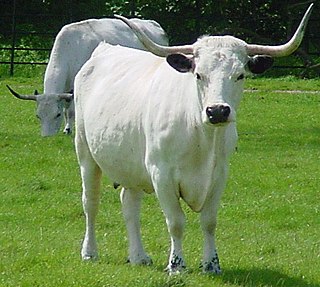
The White Park is a rare breed of ancient horned cattle primarily residing in Great Britain. Two similar semi-feral populations, the Chillingham Wild Cattle in Northumbria and the Vaynol cattle from Gwynedd in North Wales, have a separate breed status. There are relatively small numbers of the White Park cattle in the United States, where they are commonly known as the Ancient White Park in order to distinguish them from the American White Park, which is a population of the British White breed.

The Illawarra Shorthorn or Illawarra is an Australian breed of dairy cattle. Its origins are not documented, but it is thought to derive from crossbreeding of Ayrshire, Devon, and Dairy Shorthorn. The name Illawarra was abbreviated from the earlier Australian Illawarra Shorthorn, and named after Illawarra, New South Wales.
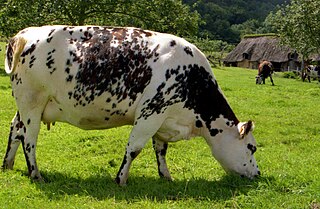
The Normande is a breed of dairy cattle from the Normandy region of north-west France. It is raised principally for its milk, which is high in fat and suitable for making butter and cheese, but also for its meat, which is marbled and good-flavoured. It is a world breed: it has been exported to many countries and is present on all continents.
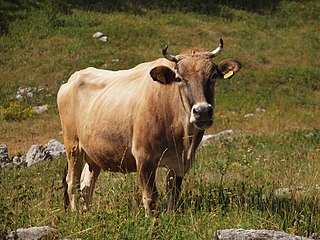
The Buša or Busha is a breed or group of breeds of small short-horned cattle distributed in south-eastern Europe, principally in Albania and the countries of the former Yugoslavia – Bosnia and Herzegovina, Croatia, Kosovo, Macedonia, Montenegro and Serbia. Related breeds include the Gurgucke, Lekbibaj and Prespa of Albania, the Gacko of Bosnia and Herzegovina, the Greek Shorthorn, the Metohija Red of Kosovo and the Rhodope Shorthorn of Bulgaria.
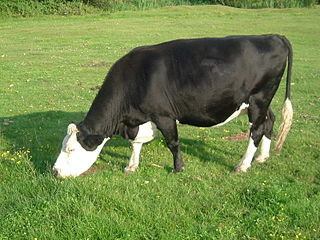
The Black Hereford is a crossbreed of beef cattle produced in Britain and Ireland with Hereford beef bulls with Angus. Black Herefords are not usually maintained from generation to generation, but are constantly produced as a byproduct of
a terminal cross. They are one of the most common types of beef cattle in Britain and Ireland, outnumbering many pure beef breeds.
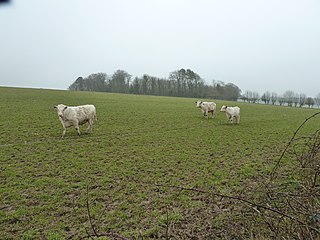
Whitebred Shorthorn is a British type of beef cattle originating in north west England and south west Scotland. It is derived from Shorthorn cattle, but is always white, rather than being the range of colours found in other Shorthorns. It has not undergone the specialisation seen in other Shorthorns, and so it remains as a more traditional hardy and thrifty cattle type. This favours its use for conservation grazing of hill pastures, grazing rank grass species to maintain a diverse flora.
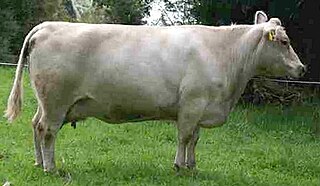
The Tasmanian Grey is a polled beef breed of silver grey, grey or dun cattle developed in Tasmania, Australia, in the 1930s.

The Podolica is a breed of domestic cattle from southern Italy. It belongs to the Podolic group of grey cattle. It is raised in the regions of Abruzzo, Basilicata, Calabria, Campania, Molise and Puglia. It was formerly distributed throughout most of mainland Italy and as far as Istria, now part of Croatia, and where it is now regarded as a separate breed, the Istrian or Boškarin. The Podolica was in the past bred principally as a draught animal; with the mechanisation of agriculture following the Second World War demand for draught oxen disappeared, and the Podolica is now raised for meat and, to a lesser extent, for milk.
The Blue Albion was a British breed of cattle with an unusual blue roan coat. It originated in the English Midlands in the late nineteenth or early twentieth century, and was a dual-purpose breed, reared both for beef and for milk. It became extinct following the foot-and-mouth outbreak of 1967.
The Droimeann cow is an endangered breed of cattle unique to Ireland. It was officially recognised as a rare native breed on 8 January 2020 following DNA profiling which showed that it was genetically distinct from other breeds. Animals may be black, red or roan, but most have a white stripe along the back. In 2020, there were 243 breeding females and 23 breeding males registered.
